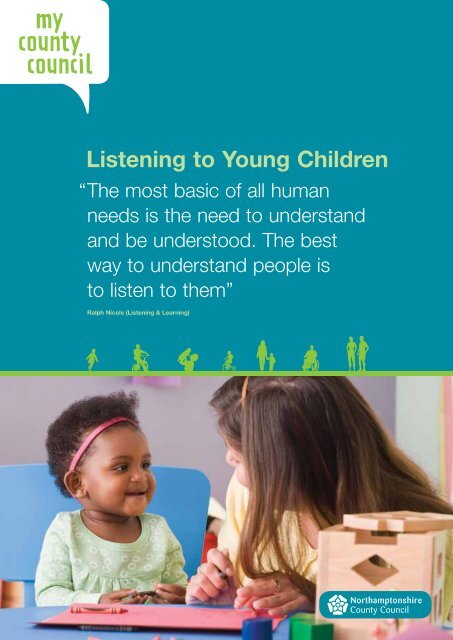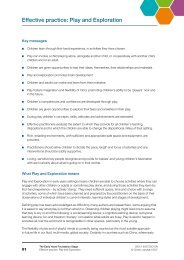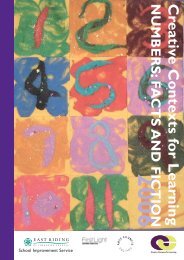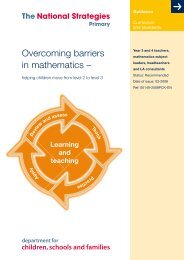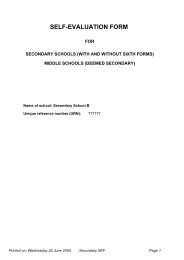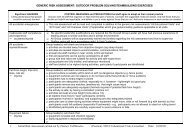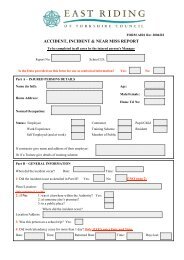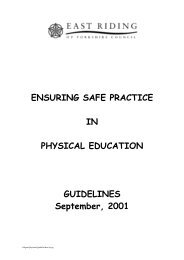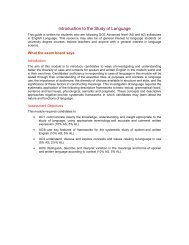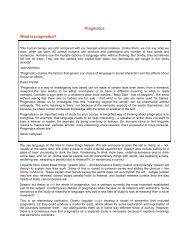Listening to Young Children - Northamptonshire County Council
Listening to Young Children - Northamptonshire County Council
Listening to Young Children - Northamptonshire County Council
Create successful ePaper yourself
Turn your PDF publications into a flip-book with our unique Google optimized e-Paper software.
<strong>Listening</strong> <strong>to</strong> <strong>Young</strong> <strong>Children</strong><br />
“ The most basic of all human<br />
needs is the need <strong>to</strong> understand<br />
and be unders<strong>to</strong>od. The best<br />
way <strong>to</strong> understand people is<br />
<strong>to</strong> listen <strong>to</strong> them”<br />
Ralph Nicols (<strong>Listening</strong> & Learning)
This <strong>to</strong>olkit aims <strong>to</strong> provide early<br />
years and childcare practitioners in<br />
Northamp<strong>to</strong>nshire with practical<br />
support and guidance for listening<br />
<strong>to</strong> young children (aged between<br />
birth and 5 years old) and including<br />
them in everyday decision<br />
making processes.<br />
There are many examples of how practitioners can listen and<br />
consult with children. The appendices section of this <strong>to</strong>olkit<br />
includes good practice case studies from different providers<br />
across Northamp<strong>to</strong>nshire that practitioners can use in their<br />
own setting. These local experiences have been tried and<br />
tested and evaluated for effectiveness and have been<br />
included in the case studies.
1<br />
UN Convention of the Rights of the Child, Article 12<br />
2<br />
The <strong>Children</strong>’s Plan: Building brighter futures–Summary pp 4<br />
www.dcsf.uk/publications/childrensplan<br />
3<br />
EYFS September 2008<br />
4<br />
SEF September 2008 tbc<br />
Legal Duty<br />
A brief outline as <strong>to</strong> why we<br />
should listen <strong>to</strong> young children.<br />
The law requires that children are<br />
included in decisions that affect<br />
them <strong>to</strong> ensure that their needs<br />
are paramount.<br />
There is a legal duty <strong>to</strong> consult with<br />
children contained within many<br />
different pieces of legislation, the<br />
following are perhaps the most<br />
relevant and recent examples:<br />
• The <strong>Children</strong> Act (2004) requires early<br />
years and childcare settings <strong>to</strong><br />
promote anti-discrimina<strong>to</strong>ry practice<br />
within all their work, and requires all<br />
adults working with children <strong>to</strong><br />
promote their needs with paramount<br />
importance;<br />
• <strong>Children</strong>’s rights <strong>to</strong> be involved in the<br />
decisions that affect them are<br />
identified in the UN Convention on<br />
the Rights of the Child – ratified by<br />
the UK in 1991 1 ;<br />
• The <strong>Children</strong>’s Plan (first published<br />
by the Department for <strong>Children</strong>,<br />
Schools and Families in 2007) states<br />
that services for children and young<br />
people “need <strong>to</strong> be shaped by and<br />
responsive <strong>to</strong> children, young people<br />
and families” 2 ;<br />
• The Early Years Foundation Stage<br />
(EYFS) is the framework that enables<br />
young children <strong>to</strong> achieve the five<br />
Every Child Matters outcomes. It sets<br />
standards for: the learning,<br />
development and care young<br />
children should experience; equality<br />
of opportunity and antidiscrimina<strong>to</strong>ry<br />
practice; partnership<br />
working; improving quality and<br />
consistency; and lays a secure<br />
foundation for future learning;<br />
• OFSTED’s Self Evaluation Framework<br />
is the mechanism by which<br />
registered providers, delivering the<br />
EYFS, consider and regularly record<br />
how they create, maintain and<br />
improve their settings. This is<br />
achieved through reflection and<br />
should also include the views of<br />
children, staff and parents.<br />
03
<strong>Listening</strong> comes in many forms;<br />
participating actively <strong>to</strong> include<br />
consulting with young children.<br />
Therefore, it is important <strong>to</strong> define<br />
what we mean by listening,<br />
participation and consultation.<br />
What does ‘listening’ mean?<br />
<strong>Listening</strong> means providing real<br />
opportunities (time, space and choice)<br />
for young children <strong>to</strong> communicate<br />
their views, concerns and aspirations<br />
(Lancaster 2003).<br />
<strong>Listening</strong> means responding <strong>to</strong> what<br />
children are saying, it means<br />
recognising that children know and can<br />
tell us things without necessarily being<br />
able <strong>to</strong> put them in<strong>to</strong> words. They<br />
express themselves through body<br />
language, expression, actions and<br />
behaviour as well as their voice.<br />
04
<strong>Listening</strong> is the<br />
art of hearing<br />
<strong>Listening</strong> includes babies. Effective<br />
listening entails respect and a belief<br />
that they are worth listening <strong>to</strong>.<br />
Adults need <strong>to</strong> give babies and<br />
young children the respect as<br />
people in their own right, competent<br />
<strong>to</strong> express their views.<br />
What does<br />
participation mean?<br />
Participation offers young children real<br />
opportunities <strong>to</strong> take part and<br />
express their views in different ways<br />
(The Hundred Languages of <strong>Children</strong><br />
– Reggio Emilia) and ensures that<br />
young children are active participants<br />
in the day-<strong>to</strong> day decisions that<br />
affect their lives.<br />
Participation means that young<br />
children’s views are heard and taken<br />
seriously. Their views are supported<br />
and upheld. As adults, we check out<br />
that we have really unders<strong>to</strong>od their<br />
intended meaning.<br />
It means recognising the existing<br />
power imbalance between adults and<br />
children. It means children are<br />
empowered rather than dominated.<br />
It recognises that we all have predetermined<br />
assumptions and cultural<br />
values that shape our views of<br />
childhood and influence how we<br />
respond <strong>to</strong> children. <strong>Children</strong> need <strong>to</strong><br />
be able <strong>to</strong> tell us what their lives are<br />
really like now.<br />
Participation helps us highlight<br />
diversity and difference and it<br />
promotes socially inclusive<br />
relationships.<br />
What does<br />
consultation mean?<br />
Consultation goes beyond listening <strong>to</strong><br />
the views of children, e.g. about how<br />
they would like things done and what<br />
resources they would like <strong>to</strong> use– it<br />
informs action which responds <strong>to</strong><br />
those views. That is – feeding back <strong>to</strong><br />
young children how their views have<br />
been acknowledged and acted on, as<br />
well as providing an explanation when<br />
it was not possible <strong>to</strong> act on them.<br />
It means ensuring young children are<br />
given information about things that<br />
might change in a way they can<br />
understand. It means making clear<br />
what opportunities young children have<br />
<strong>to</strong> make decisions and that they can<br />
also change their minds later.<br />
Informing young children when action<br />
is taking place and providing an<br />
explanation when their ideas are not<br />
turned in<strong>to</strong> action. Sharing children’s<br />
views provides a valuable opportunity<br />
<strong>to</strong> celebrate achievements and discuss<br />
future plans that affect their learning<br />
and development.<br />
“Asking children what they think, but taking<br />
it no further will send a message that there<br />
is little real interest in their view”<br />
Mooney and Blackburn 2002<br />
05
Continued<br />
Professional Development<br />
Good listening does not happen by<br />
accident. It is an acquired skill, and<br />
with a consistent approach we can<br />
all help all children in our settings.<br />
Many practitioners are very supportive<br />
of children’s listening, but because<br />
they do it intuitively, are not really<br />
aware of what works best and why e.g.<br />
eye contact, attending <strong>to</strong> the speaker,<br />
remembering and responding <strong>to</strong> what<br />
is said.<br />
It is an ongoing learning process.<br />
Developing a listening culture needs <strong>to</strong><br />
be explored thoroughly and needs <strong>to</strong><br />
be unders<strong>to</strong>od by practitioners in the<br />
setting. Continued professional<br />
development is important and with<br />
many settings having high staff<br />
turnover it is more important <strong>to</strong> ensure<br />
that your staff members have the<br />
appropriate training.<br />
Benefits for All<br />
It is not just about legal duties,<br />
listening <strong>to</strong> and consulting with<br />
children benefits early years settings<br />
enormously by:<br />
• Enhances emotional wellbeing and<br />
raising their self esteem;<br />
• Developing a genuinely collaborative<br />
and inclusive play and learning<br />
environment;<br />
• Recognising and celebrating<br />
diversity;<br />
• Increasing knowledge and<br />
understanding of how children<br />
respond <strong>to</strong> and value their<br />
environment;<br />
• Ensuring children’s individual needs<br />
are met;<br />
• Supporting the quality of provision;<br />
• Provide evidence for Quality<br />
Assurance and Self reflection;<br />
• Providing evidence <strong>to</strong> inform Ofsted’s<br />
self-evaluation framework document;<br />
• Developing decision-making skills;<br />
• Developing overall understanding;<br />
• Creating a sense of responsibility for<br />
oneself and others;<br />
• Contributing <strong>to</strong> play and learning<br />
experiences.<br />
06
<strong>Listening</strong> <strong>to</strong> <strong>Young</strong><br />
<strong>Children</strong> Resource Pack<br />
Coram Family Training<br />
This resource pack was developed by<br />
Coram family. It uses the visual arts <strong>to</strong><br />
enable young children under the age of<br />
eight <strong>to</strong> articulate their experiences,<br />
express their views, choices, feelings<br />
and concerns. It explains how listening<br />
can be embedded in every day practice<br />
and examines how <strong>to</strong> ‘tune in<strong>to</strong>’ young<br />
children, including babies. It shows how<br />
reflective practice can promote<br />
children’s participation in decision<br />
making and problem solving processes<br />
<strong>to</strong> inform and enhance their learning<br />
environments. It supports the essential<br />
underpinnings of the Early Years<br />
Foundation Stage from the Every Child<br />
Matters agenda and key outcomes.<br />
The resource is in five parts<br />
1 The Introduc<strong>to</strong>ry Guide –<br />
an overview of the contents.<br />
2 The Reader – provides the<br />
conceptual background and looks at<br />
three key strands, which support<br />
children’s participation: An inclusive<br />
approach, a participative approach<br />
and a supportive framework.<br />
3 The Practitioner Handbook –<br />
sets out the key components of<br />
active listening and how <strong>to</strong> promote<br />
a listening culture.<br />
4 A set of Shared Experiences –<br />
in eleven individual case study<br />
booklets based on the visual arts.<br />
5 CD-Rom – illustrates 10 of the 11<br />
Shared Experiences.<br />
07
It aims <strong>to</strong>:<br />
• Promote holistic approaches.<br />
• Offers real opportunities for young<br />
children <strong>to</strong> participate.<br />
• Create an accessible environment<br />
that enables children <strong>to</strong> express their<br />
views, choices, concerns,<br />
experiences and aspirations and <strong>to</strong><br />
take these seriously.<br />
• Develop socially inclusive adult<br />
- child relationships where young<br />
children know they will be heard.<br />
• Strengthens the listening skills and<br />
attitudes of parents and practitioners.<br />
It provides a framework that adults can<br />
implement <strong>to</strong> support listening <strong>to</strong><br />
young children by:<br />
Recognising a child’s many visual<br />
and verbal languages<br />
Assigning space for children’s<br />
voices <strong>to</strong> be heard<br />
Making time for children’s voices<br />
Providing genuine choices<br />
Subscribing <strong>to</strong> reflective practice<br />
The aim of the eleven Shared<br />
Experiences is <strong>to</strong> be inspirational and<br />
flexible <strong>to</strong> enable parents and<br />
practitioners <strong>to</strong> tune in<strong>to</strong> young<br />
children through observing their<br />
responses <strong>to</strong> a range of shared<br />
experiences such as: Likes and<br />
Dislikes; Visual Walks, Tuning In,<br />
Capturing <strong>Children</strong>’s Experience. A<br />
spiral framework is provided <strong>to</strong> support<br />
practitioners when using these shared<br />
experiences – known as PPR which is<br />
Preparation, Process and Reflection.<br />
The PPR signposts issues <strong>to</strong> address<br />
so that listening <strong>to</strong> and observing<br />
what children are saying and doing<br />
improves practice.<br />
Ultimately the <strong>Listening</strong> <strong>to</strong> <strong>Young</strong><br />
<strong>Children</strong> Resources Pack offers an<br />
ethical and practical framework and<br />
demonstration of how listening <strong>to</strong><br />
young children can be implemented in<br />
a meaningful way that promotes best<br />
practice across all childcare settings, It<br />
provides a springboard for fun,<br />
creativity and fulfilling partnerships<br />
between children and their key carers<br />
for young children up <strong>to</strong> 8 years old.<br />
These key principles can be adapted<br />
for children beyond eight.<br />
This Resource Pack is the core of a<br />
successful training programme offered<br />
within the Multi-Agency Training guide<br />
and has been the springboard <strong>to</strong><br />
developing a number of ‘listening <strong>to</strong><br />
young children’ approaches in settings<br />
across Northamp<strong>to</strong>nshire. Some of<br />
these are described in the appendices<br />
of this booklet.<br />
08
Strategies <strong>to</strong> improve<br />
listening skills<br />
A reflective early year’s learning<br />
environment is not only conducive <strong>to</strong><br />
achievement, but it is also required by<br />
the EYPS and the EYFS. Standard 22<br />
of the requirements for Early Years<br />
Professional Status (EYPS) states that<br />
practitioners need <strong>to</strong> ‘give constructive<br />
and sensitive feedback <strong>to</strong> help children<br />
understand what they have achieved<br />
and think about what they need <strong>to</strong> do<br />
next and… <strong>to</strong> think about, evaluate<br />
and improve on their own<br />
performance.’ (CWDC, 2006, p10).<br />
As discussed earlier it is also a<br />
requirement of the Early Years<br />
Foundation Stage (EYFS), under<br />
Personal, Social and Emotional<br />
Development, that we help children <strong>to</strong><br />
‘know themselves and what they can<br />
do’ (DfES, 2007, p22).<br />
The EYFS Profile also highlights that<br />
‘the importance of involving children in<br />
the assessment process is <strong>to</strong> enable<br />
them <strong>to</strong> develop their ability <strong>to</strong> express<br />
preferences and make choices, begin<br />
<strong>to</strong> understand that their views are<br />
respected and develop as au<strong>to</strong>nomous<br />
learners’ (QCA, 2003, p103).<br />
How are children’s<br />
views sought?<br />
Different ways of listening<br />
<strong>to</strong> young children:<br />
• Visual observations of children,<br />
written notes and pho<strong>to</strong>graphs.<br />
• Use of camcorders <strong>to</strong> record<br />
children’s activities that can be<br />
shared in discussions.<br />
• Pho<strong>to</strong>graph books in book corners <strong>to</strong><br />
promote discussion.<br />
• <strong>Children</strong> taking pho<strong>to</strong>graphs of<br />
things they would like the new<br />
children <strong>to</strong> know about the setting.<br />
• Thinking tree – children can ‘pose’<br />
thoughts for adults <strong>to</strong> consider<br />
when planning.<br />
• Giving choice – e.g. Choice books<br />
that show range of equipment that is<br />
available but restricted by space <strong>to</strong><br />
display it all.<br />
• <strong>Listening</strong> can place any time, any<br />
place…<br />
• Sustained, shared conversations.<br />
• Giving children time, space, flexibility<br />
<strong>to</strong> make choices.<br />
• Involve children in the planning.<br />
• The environment needs <strong>to</strong> allow <strong>to</strong><br />
listening time, body language, eye<br />
contact. Further more, it is very<br />
important <strong>to</strong> create an environment<br />
that is conducive <strong>to</strong> listening and<br />
noticing e.g. keeping distractions <strong>to</strong><br />
a minimum - some children cannot<br />
concentrate fully if there is<br />
background noise such as a<br />
television, radio or computer games.<br />
Vary ways of asking children such as<br />
verbal questions, using cameras,<br />
questionnaires, ideas boxes etc.<br />
Some of these examples are further explored in the appendices (case studies)<br />
and in the subsequent sections of this <strong>to</strong>olkit.<br />
9
Being Self Reflective<br />
As anyone working with young<br />
children will know, we learn by<br />
looking back at what we did and<br />
how <strong>to</strong> improve outcomes for<br />
children by doing things differently.<br />
One way of checking how we are<br />
listening <strong>to</strong> young children is by<br />
being reflective.<br />
Section 4 of the Self Evaluation document<br />
asks providers <strong>to</strong> record the views of<br />
children and their parents or carers who<br />
are using the setting. The voice of the<br />
child needs <strong>to</strong> be included when<br />
reflecting on your practice – examples of<br />
when you have listened <strong>to</strong> young children<br />
and their parents or carers.<br />
10
Improving outcomes<br />
for children<br />
• Outcomes from consultations<br />
need <strong>to</strong> be recorded as evidence.<br />
Keeping accurate records not only<br />
supports accurate consultations,<br />
but it also helps you <strong>to</strong> reflect on<br />
practice <strong>to</strong> inform any future<br />
consultation activities.<br />
• Raising self esteem of all children.<br />
• Creating high levels of well being in<br />
staff and children and their families.<br />
• Measuring children’s well being<br />
through observations, putting in<br />
strategies <strong>to</strong> improve the low levels<br />
of well being in some children.<br />
• Effective key person system.<br />
• High quality emotional environment<br />
that supports children learning and<br />
development.<br />
• Flexible approach <strong>to</strong> planning that<br />
reflects children interests and<br />
developmental needs.<br />
• The skill of the practitioners <strong>to</strong> know<br />
how <strong>to</strong> listen <strong>to</strong> the children, using an<br />
underpinning knowledge of child<br />
development.<br />
• Role modelling effective<br />
communication skills, both verbal<br />
and non verbal.<br />
• Allow time for reflection.<br />
• Allow time <strong>to</strong> listen and value<br />
conversation.<br />
• Allowing children time <strong>to</strong> respond<br />
<strong>to</strong> adults.<br />
• The benefits of listening <strong>to</strong> children<br />
supports their interests at that<br />
moment in time.<br />
• Communication is not only the<br />
spoken word, but communication<br />
through paintings, or role play,<br />
and dance!<br />
• Providing an environment that is<br />
safe, and somewhere they want<br />
<strong>to</strong> be, allowing a comfortable<br />
place <strong>to</strong> listen and share and<br />
express themselves.<br />
• A reflective practitioner needs <strong>to</strong><br />
evaluate and moni<strong>to</strong>r opportunities<br />
for children <strong>to</strong> be listened <strong>to</strong>o.<br />
• Moni<strong>to</strong>ring process needs <strong>to</strong><br />
be completed by an experienced<br />
practitioner who is well versed<br />
in ‘listening <strong>to</strong> young<br />
children’ principles.<br />
• The environment should foster<br />
independent access <strong>to</strong> resources<br />
where possible or appropriate.<br />
• Evidence of the impact of listening <strong>to</strong><br />
children, <strong>to</strong> support your SEF<br />
(Section 1 Views of those who use<br />
your setting).<br />
11
Understanding children’s<br />
ways of communication<br />
<strong>Children</strong> communicate how they<br />
feel and what they want, <strong>to</strong> adults<br />
who ‘tune in’ with all their senses.<br />
They recognise all of their<br />
children’s actions and interpret<br />
these in order <strong>to</strong> respond in the<br />
best possible way.<br />
A key person system enables the<br />
practitioner <strong>to</strong> get <strong>to</strong> know the child<br />
and their family <strong>to</strong> recognise and be<br />
responsive <strong>to</strong> their individual needs.<br />
Adults need <strong>to</strong> secure knowledge of<br />
child development <strong>to</strong> be skilled<br />
listeners and have an underpinning<br />
knowledge of the stages of children’s<br />
communication skills. (The Science of<br />
Language- John Kirche).<br />
12
Practitioners need <strong>to</strong> have<br />
regard <strong>to</strong> the development<br />
matters statements in the<br />
EYFS Practice Guidance.<br />
Understanding listening is key <strong>to</strong><br />
providing an environment in which all<br />
young children feel confident, safe and<br />
powerful, ensuring they have time and<br />
space <strong>to</strong> express themselves in<br />
whatever form suits them.<br />
Taken from ‘The Enabling<br />
Environments’ Page 42 EYFS<br />
Guidance - it is advocated that<br />
practitioners need <strong>to</strong> provide time and<br />
relaxed opportunities for children <strong>to</strong><br />
develop spoken language though<br />
sustained conversations, both 1-1 and<br />
in small groups and between the<br />
children themselves. Practitioners need<br />
<strong>to</strong> allow time for children <strong>to</strong> initiate<br />
conversations, respect their thinking<br />
time and silences and help them <strong>to</strong><br />
develop the interaction.<br />
All children are unique with unique<br />
responses. Observing children is as<br />
important as listening <strong>to</strong> what they say;<br />
much of what children say would not<br />
make much sense without observation.<br />
<strong>Children</strong> communicate through their<br />
body language and facial expressions.<br />
They respond in ways they have learnt<br />
<strong>to</strong> be appropriate, such as eyecontact,<br />
though this depends on<br />
different cultural traditions. <strong>Listening</strong> <strong>to</strong><br />
children with disabilities may involve<br />
learning new communication<br />
techniques or fine-tuning skills they<br />
use every day. Practitioners need <strong>to</strong><br />
value and support the communication<br />
skills of children with Special<br />
Educational Needs and English as an<br />
Additional Language and know how <strong>to</strong><br />
access the relevant support and<br />
advisory services. Keeping daily diaries<br />
of children’s observation can help with<br />
planning activities around the child’s<br />
wants and needs.<br />
Practitioners need <strong>to</strong> know how <strong>to</strong><br />
access documents, strategies,<br />
research, theories and support e.g.<br />
ECAT, EEL, Letters and Sounds,<br />
SEAD (Social, Emotional Aspects of<br />
Development) etc. They should also<br />
show a commitment <strong>to</strong> working with<br />
families and other professionals in<br />
order <strong>to</strong> promote the voice of the child.<br />
13
<strong>Listening</strong> <strong>to</strong> babies<br />
“By watching your baby – understand that<br />
your baby’s behaviour is not random but can<br />
tell you something about how the baby is<br />
experiencing the world – you can be guided<br />
<strong>to</strong> give the care that is most appropriate”<br />
The Social Baby (2000)<br />
<strong>Listening</strong> <strong>to</strong> babies acknowledges their<br />
right <strong>to</strong> be heard from pre birth and<br />
throughout their lives. It builds up<br />
positive relationships between adults<br />
and babies. Babies demand constant<br />
attention. Babies are social beings<br />
from birth. Even at 20 minutes old a<br />
baby may imitate facial expression<br />
presented <strong>to</strong> them by an adult.<br />
<strong>Listening</strong> and observing babies<br />
practitioners can gain an insight; a<br />
deeper level of understanding of the<br />
babies in their care. It begins with<br />
effective listening – demonstrating<br />
respect and belief that babies are<br />
worth listening <strong>to</strong> thus providing for<br />
their needs and improving a baby’s<br />
well being. Seeing the world from a<br />
baby’s point of view is a good start <strong>to</strong><br />
understanding what babies are saying,<br />
interpreting their sounds and<br />
movements and reading their<br />
body language.<br />
Babies’ communication includes all<br />
senses and emotions. For example;<br />
Verbal: gurgling, squealing, crying,<br />
and laughing.<br />
Non-verbal: clenching fists, arm<br />
movements, facial expressions, back<br />
arching, body rigidity, eye contact.<br />
14
“The qualities of good parenting (and care)<br />
are...the capacity <strong>to</strong> listen, <strong>to</strong> notice, <strong>to</strong><br />
shape behaviour and <strong>to</strong> res<strong>to</strong>re good<br />
feelings through some kind of physical,<br />
emotional or mental contact, through a<br />
<strong>to</strong>uch, a smile, a way of putting feelings<br />
and thoughts in<strong>to</strong> words. To be able <strong>to</strong><br />
notice and respond <strong>to</strong> other’s feeling, takes<br />
up time. It requires a kind of mental space<br />
<strong>to</strong> be allocated <strong>to</strong> feelings and a<br />
willingness <strong>to</strong> prioritise relationships.”<br />
Why Love Matters, Sue Gerhardt (2004)<br />
Practitioners can listen<br />
in the following ways<br />
• Informal observation is the easiest<br />
way <strong>to</strong> listen <strong>to</strong> babies. It will help<br />
you see the world through their eyes<br />
• Using a tally chart <strong>to</strong> moni<strong>to</strong>r a<br />
baby’s movement will help you<br />
moni<strong>to</strong>r which <strong>to</strong>ys a baby chooses<br />
<strong>to</strong> play with or an area they choose<br />
<strong>to</strong> play in. It will tell you their likes<br />
and dislikes.<br />
• Tuning in <strong>to</strong> their body language<br />
will help you understand how babies<br />
are feeling and responding <strong>to</strong><br />
different experience.<br />
• Recording a baby’s sounds and<br />
actions and how you respond.<br />
• Encourage and reward their<br />
communication by responding<br />
with interest (use smiles, cuddles<br />
and praise).<br />
• Notice how they express feelings of<br />
happiness and distress by for<br />
example smiling, gurgling, hand<br />
waving, grimacing, turning away etc.<br />
• Asking parents/carers about how<br />
their baby communicates, their<br />
preferences and routines.<br />
Every child has different signals and<br />
ways of communicating how they feel.<br />
15
Challenges<br />
Busy home environment or setting –<br />
look at noise levels and consider<br />
creating a quiet area.<br />
Having time <strong>to</strong> focus on babies.<br />
Parents who don’t have time <strong>to</strong> engage<br />
with practitioner.<br />
The number of adults that may care<br />
for the same baby: e.g. parents living<br />
in separate homes, childminders<br />
and settings.<br />
Hints and Tips<br />
Collect information from parents before<br />
placement starts – by designing your<br />
own baby friendly ‘All about Me’ pro<br />
forma that is accessible <strong>to</strong> parents/<br />
carers and easy <strong>to</strong> complete.<br />
Share observations with parents.<br />
Daily diaries.<br />
Settling in process and policy e.g.<br />
home visits.<br />
Thinking about opportunities <strong>to</strong> listen<br />
<strong>to</strong> babies e.g. using key one-<strong>to</strong>-one<br />
interaction opportunity when nappy<br />
changing or feeding times.<br />
Reflection<br />
Do you know how each baby likes <strong>to</strong><br />
sleep and do you respect these<br />
preferences?<br />
Do you adapt activities and routines <strong>to</strong><br />
follow the interests of the babies?<br />
Do you try <strong>to</strong> see the world and<br />
environment through the eyes of the<br />
baby?<br />
Have you ‘tuned in<strong>to</strong>’ each baby’s<br />
verbal and non-verbal cues?<br />
Do you make one <strong>to</strong> one time <strong>to</strong> listen<br />
<strong>to</strong> babies and build relationships?<br />
Do you give the baby time <strong>to</strong> respond<br />
<strong>to</strong> you? Your words, your actions, your<br />
facial expressions, sounds you make,<br />
sounds they hear.<br />
If you are Solihull Approach trained,<br />
keep the ‘dance of reciprocity’ in mind.<br />
A quiet baby does not always indicate<br />
a happy baby.<br />
Useful References:<br />
‘<strong>Listening</strong> as a way of life’ Diane Rich<br />
(National <strong>Children</strong>’s Bureau)<br />
Talk <strong>to</strong> babies but always give<br />
opportunity for them <strong>to</strong> talk back.<br />
16
Involving young<br />
children in Recruitment<br />
CWDC has adopted the United Nations<br />
Convention on the Rights of the Child<br />
(UNCRC) in its entirety. Article 12 of the<br />
UNCRC says that all children and<br />
young people have the right <strong>to</strong> say<br />
what they think should happen when<br />
adults are making decisions that affect<br />
them, and <strong>to</strong> have those opinions<br />
taken in<strong>to</strong> account; this includes the<br />
people who work with them.<br />
It is important <strong>to</strong> stress that the<br />
employer must have robust and<br />
rigorous recruitment procedures in<br />
place which ensure that staff meet the<br />
specific requirements of the role and<br />
are safe <strong>to</strong> work with children.<br />
Why do we involve children<br />
in recruitment & selection?<br />
Involving children in recruitment has<br />
countless benefits. Before recruiting,<br />
ask children what attributes they like<br />
in workers, non-verbal children may<br />
be able <strong>to</strong> sign or indicate preferences.<br />
<strong>Children</strong>’s voices can be reflected<br />
in adverts.<br />
• Feeling valued and empowered<br />
leading <strong>to</strong> raising children’s<br />
self esteem.<br />
• Interaction can be observed<br />
including body language, eye<br />
contact, facial expression and hand<br />
gestures which can indicate<br />
children’s feelings, preferences<br />
and engagement.<br />
• Direct observation of children<br />
participating in recruitment can be<br />
useful particularly if children and<br />
young people are unable <strong>to</strong><br />
communicate verbally. Watching non<br />
verbal communication such as body<br />
language, eye-contact, facial<br />
expressions or hand gestures can tell<br />
you a lot.<br />
Activities could include:<br />
Reading with the children<br />
Eating with the children<br />
Doing activities with the children<br />
<strong>Children</strong> could show candidates or<br />
new recruits around the setting<br />
<strong>Children</strong> will be involved and their<br />
well-being enhanced by contributing<br />
<strong>to</strong> staff selection.<br />
• Babies are social beings and can<br />
express their likes and dislikes.<br />
Adults need <strong>to</strong> be sensitive <strong>to</strong> signals<br />
and responses.<br />
• Benefits for organisations e.g. better<br />
targeted services, chance <strong>to</strong> see<br />
recruits with young children.<br />
• Pre employment visits give children<br />
the opportunity <strong>to</strong> meet potential<br />
staff and express their views.<br />
• Candidates should be invited <strong>to</strong> visit<br />
the setting so that their interactions<br />
with the children and the children’s<br />
responses <strong>to</strong> them can be observed.<br />
17
Case Studies<br />
Thorplands<br />
<strong>Children</strong>’s Centre<br />
Joanne Ashworth<br />
Specific Aims:<br />
To develop key worker system role and knowledge<br />
of children’s prepared activities.<br />
To find out about children’s likes and dislikes<br />
regarding activities.<br />
Developing engagement at group time<br />
To inform Development Folder for each child.<br />
Activity:<br />
We used the booklet ‘Capturing <strong>Children</strong>’s Experiences’<br />
from the Coram resource pack <strong>to</strong> help with our planning.<br />
<strong>Children</strong> were encouraged <strong>to</strong> take pho<strong>to</strong>graphs or draw<br />
pictures of the activities they enjoyed during the session<br />
with the support of the staff members. The pho<strong>to</strong>s and<br />
drawings were placed on the key worker board and<br />
discussed at the end of the session during group time.<br />
<strong>Children</strong> described their own pho<strong>to</strong>s/pictures and the<br />
adults transcribed underneath <strong>to</strong> make clear what the<br />
child was saying.<br />
We entered the children’s pho<strong>to</strong>s and drawings in their<br />
Development Folders so that the children could have<br />
access <strong>to</strong> them and look through them when they<br />
wanted. It was also a good opportunity <strong>to</strong> share them<br />
with their parents/carers and created a discussion point<br />
at parent’s evening.<br />
The activity enhanced the knowledge of the child for the<br />
key worker. It informed planning regarding preferred<br />
activities and promoted sharing and listening skills<br />
between children and developed their language skills. It<br />
also contributed <strong>to</strong>wards their positive self esteem<br />
We have embedded this activity in<strong>to</strong> our practice and<br />
further expanded using pho<strong>to</strong>graphs on the board. There<br />
are many benefits in doing this activity including<br />
developing use of language and communication and<br />
provided a real opportunity <strong>to</strong> listen <strong>to</strong> what the children<br />
are saying and in turn they feel valued and their self<br />
esteem increased.<br />
Penrith Drive <strong>Children</strong>’s<br />
Centre, Wellingborough<br />
Georgina Goodman and Kay O’Reilly<br />
Specific Aims:<br />
The project began in February 2010. We created a flyer <strong>to</strong><br />
invite as many parents/carers <strong>to</strong> our event which we called<br />
‘Dragon Fun’ <strong>to</strong> celebrate the Chinese New Year. The<br />
purpose was <strong>to</strong> increase children’s confidence and listening<br />
techniques for all, including parents/carers and staff.<br />
Activity:<br />
Using the Coram Family Resource pack we selected<br />
‘Painting’ <strong>to</strong> share experiences and offer the children real<br />
freedom <strong>to</strong> experiment with paint and use it <strong>to</strong> explore<br />
their ideas, their feelings and situations.<br />
Before the session began we asked the parents/carers <strong>to</strong><br />
complete a brief questionnaire that looked at<br />
expectations and importance of the activity. For example,<br />
1. What do you think children will learn from<br />
painting; do you do painting at home?<br />
2. Why do you think painting is important?<br />
3. How confident do you feel about your child<br />
painting at home?<br />
They were also asked <strong>to</strong> rate the activity before and after<br />
on a scale of 1-5 where 1 = not confident and 5 = very<br />
confident.<br />
The key <strong>to</strong> our project is preparation. We collected<br />
comments before the session and after the session from<br />
both parents/carers and the young children involved. This<br />
was <strong>to</strong> help inform any future sessions we plan.<br />
We collected lots of different objects for the children and<br />
parents <strong>to</strong> use and create something <strong>to</strong> paint, including<br />
large and small boxes, cylinder objects etc. ‘Junk<br />
modelling’ is a good way for young children <strong>to</strong> express<br />
themselves, providing them with an opportunity <strong>to</strong> do<br />
what they wanted and not be focused on specific<br />
outcomes. Our outcome was <strong>to</strong> provide and opportunity<br />
for parents/carers <strong>to</strong> engage with their children. We<br />
provided ample space for the children <strong>to</strong> use <strong>to</strong> their<br />
advantage, and create something as big or as small as<br />
they wanted.<br />
18
We videoed the activity and later used it <strong>to</strong> show the<br />
parents about how their children were using their<br />
imagination and exploration of the objects <strong>to</strong> convey their<br />
feelings in the painting activity.<br />
Many parents/carers were surprised at how much their<br />
children expressed themselves at using other available<br />
resources so confidently and imaginatively. Some<br />
parents/carers said they would feel more confident <strong>to</strong> try<br />
this activity at home.<br />
Busy Bees Preschool/<br />
Playgroup<br />
Ann Byford and Hilary Hamil<strong>to</strong>n<br />
Specific Aims:<br />
Our listening <strong>to</strong> young children project had several aims<br />
including <strong>to</strong> help children make choices, <strong>to</strong> help<br />
communication with children and <strong>to</strong> settle in new children.<br />
Activity:<br />
To produce a pho<strong>to</strong> Album of all the <strong>to</strong>ys in the setting<br />
and label it as a resource book. We believe that<br />
producing a pho<strong>to</strong>graphic book of all the <strong>to</strong>ys and<br />
activities that we have available would help children<br />
further <strong>to</strong> make choices and voice what they would like <strong>to</strong><br />
do. The children helped us take pho<strong>to</strong>graphs of the <strong>to</strong>ys<br />
and then we had two copies produced. We used the<br />
‘Likes and Dislikes’ booklet from the Coram Resource<br />
pack <strong>to</strong> guide us.<br />
The first set of pho<strong>to</strong>graphs were laminated and<br />
separated <strong>to</strong> the different areas of development and filed<br />
in an A4 folder. This folder was then placed for easy<br />
access <strong>to</strong> children and parents/carers.<br />
The folder is used for many different purposes:<br />
• Staff used the folder for planning, <strong>to</strong> identify activities<br />
<strong>to</strong> meet the developmental needs of the children in<br />
their care.<br />
• The children made their own decisions about what they<br />
would like <strong>to</strong> play with.<br />
• It helped settle newly arrived children by giving them<br />
the folder <strong>to</strong> look at and decide what they wanted <strong>to</strong> do<br />
- a new setting with lots of children and <strong>to</strong>ys as we<br />
know can be overwhelming. One child who was new <strong>to</strong><br />
the setting always asked for the folder <strong>to</strong> choose what<br />
she wanted <strong>to</strong> play with. She became more settled as a<br />
result and started <strong>to</strong> use her voice more. We believe it<br />
was the resource folder that helped her <strong>to</strong> do this.<br />
• It also helped children <strong>to</strong> choose what they wanted <strong>to</strong><br />
play with but who were less verbal.<br />
• A potential parent/carer came <strong>to</strong> visit the setting<br />
<strong>to</strong>wards the end of the day after everything was<br />
packed away. We were able <strong>to</strong> use the folder <strong>to</strong> share<br />
what resources the setting had with potential new<br />
parents/cares when they came <strong>to</strong> look around. It<br />
helped <strong>to</strong> explain how children are encouraged <strong>to</strong><br />
make choices and <strong>to</strong> be independent.<br />
The second set of pho<strong>to</strong>graphs were used <strong>to</strong> create an<br />
identical folder <strong>to</strong> help us review activities for the day.<br />
Using a large plastic clear pocket sheet with lots of<br />
individual pockets, we placed the activities that children<br />
played with during the day in them. We laminated happy<br />
and sad faces and the children, parents/carer and staff<br />
were encouraged <strong>to</strong> put a smiley or a sad face in each<br />
activity pocket. The children found this an exciting new<br />
game. However, once the initial excitement had worn off,<br />
the children used the happy and sad faces <strong>to</strong> describe<br />
how they felt about the activity they participated in, and<br />
key workers came alongside <strong>to</strong> hear what they had <strong>to</strong><br />
say. We have found it <strong>to</strong> be a great reflection <strong>to</strong>ol which<br />
will inform our future planning.<br />
Tudor Manor Day Nursery,<br />
Project: Feeling S<strong>to</strong>ne<br />
Vikki Cox and Gemma Humphreys<br />
Specific Aims:<br />
To involve the children in making choices around the<br />
nursery in everyday activities including outside play area.<br />
To enable staff <strong>to</strong> listen <strong>to</strong> young children <strong>to</strong> talk about<br />
their feelings.<br />
Activity:<br />
We wanted the young children <strong>to</strong> share responsibility in<br />
the planning of our project; choosing <strong>to</strong>ys and other<br />
activities <strong>to</strong> play with. We used the Feelings booklet from<br />
the Coram resource pack <strong>to</strong> help give us some ideas.<br />
In our nursery each room has designated areas for the 6<br />
areas of learning; Maths; Communication, Language and<br />
Literacy; Personal, Social and Emotional development;<br />
Knowledge and Understanding of the World; Physical<br />
development; Creative development. We decided <strong>to</strong><br />
concentrate on activities addressing 2 of the 6 areas of<br />
learning as we foresaw difficulties in managing all 6 areas<br />
due <strong>to</strong> lack of s<strong>to</strong>rage. During our group times (with<br />
children aged 3-5) we explained <strong>to</strong> the children what we<br />
were going <strong>to</strong> do and included them in all the planning.<br />
We <strong>to</strong>ok pho<strong>to</strong>graphs of the <strong>to</strong>ys and activities available<br />
in the 2 areas of learning and developed an activity wall<br />
and labelled it ‘what we have chosen <strong>to</strong> have out’.<br />
19
The older children were able <strong>to</strong> talk about the choices<br />
during group time with each other and why they made<br />
their choice and how they went about making their<br />
choices. The 1-2 year old children copied the older<br />
children. This helped children increase their self esteem.<br />
They were comfortable <strong>to</strong> go and choose their own<br />
activities. Furthermore, we dedicated a wall space with<br />
felt material so that the younger children could choose<br />
their own work <strong>to</strong> display using Velcro. We found that all<br />
the children were more engaged with the <strong>to</strong>ys and<br />
activities they had chosen and the older children were<br />
more involved in the display activity, i.e. where <strong>to</strong> put<br />
work displays and how it should look. This activity helped<br />
members of staff <strong>to</strong> listen <strong>to</strong> children’s feelings, hear what<br />
they gained from the activity and understand their<br />
emotional state and well being.<br />
Emotions Tree and Feelings S<strong>to</strong>ne<br />
We had a decorative willow which we used as our<br />
emotions tree. The s<strong>to</strong>ne was large enough for children<br />
<strong>to</strong> hold in their hands and very smooth <strong>to</strong> the <strong>to</strong>uch.<br />
We introduced the s<strong>to</strong>ne during group time <strong>to</strong> explain the<br />
idea. We made ‘emotion’ labels with different emotions<br />
and placed them within reach for the children and placed<br />
the feelings s<strong>to</strong>ne in a basket under the ‘tree’. Everything<br />
was within reach and accessible <strong>to</strong> the children. <strong>Children</strong><br />
could hold the s<strong>to</strong>ne and rub their emotions in<strong>to</strong> it when<br />
they were feeling happy or sad or wanted some comfort.<br />
The younger children often copied the older children.<br />
The feelings s<strong>to</strong>ne also helped one child who was having<br />
difficulty settling in.<br />
We cut out lots of pic<strong>to</strong>rial faces with different emotions<br />
that were clearly depicted e.g. happy face, sad face,<br />
worried face etc. We made the labels and laminated them<br />
and used ribbon <strong>to</strong> hang them on the tree. The children<br />
were able <strong>to</strong> hang their feelings on the tree. This could be<br />
done session by session and helped members of staff <strong>to</strong><br />
gauge the emotional well being of the children in their<br />
care as well as provide an opportunity <strong>to</strong> engage with<br />
them at a deeper level<br />
We regularly communicated children’s emotional<br />
behaviour with their parents/carers when they came <strong>to</strong><br />
pick them up so that they were aware. This helped them<br />
<strong>to</strong> ‘tune in’ <strong>to</strong> their children’s moods and feelings.<br />
Oakway <strong>Children</strong>`s Centre<br />
Debbie Wright and Felicity Botterill<br />
Specific Aims:<br />
To develop children`s speech and language.<br />
To encourage parents <strong>to</strong> listen <strong>to</strong> their child & encourage<br />
parent /child interaction.<br />
The Project was promoted through the “What`s On”<br />
leaflet at the <strong>Children</strong>`s Centre that is distributed <strong>to</strong> all<br />
parents and a variety of community settings locally.<br />
We participated on the <strong>Listening</strong> <strong>to</strong> <strong>Young</strong> <strong>Children</strong><br />
Course delivered by Northamp<strong>to</strong>nshire <strong>County</strong> <strong>Council</strong>;<br />
however, we did not use sources from the Shared<br />
Experiences from the Coram Resource pack but adapted<br />
ideas from the Coram course <strong>to</strong> address the needs in our<br />
setting. We had received many requests from parents for<br />
help with behaviour management with their children. We<br />
found a lot of parents struggled with behaviour<br />
management and believed it was as a result of lack of<br />
listening skills; listening <strong>to</strong> what their child was saying<br />
leading <strong>to</strong> difficult behaviour for them <strong>to</strong> manage. To<br />
support this we decided <strong>to</strong> use this opportunity <strong>to</strong><br />
address this in our Centre. We wanted <strong>to</strong> help parents/<br />
carers really listen <strong>to</strong> their children in the <strong>Children</strong>’s<br />
Centre and at home <strong>to</strong>o.<br />
Activity:<br />
The ‘Chattersacks’ concept is similar <strong>to</strong> that of the<br />
‘s<strong>to</strong>rysacks’ concept. They already existed with our<br />
resources at the Centre. We decided <strong>to</strong> take it a step<br />
further and introduce it as a resource <strong>to</strong> support<br />
behaviour management and <strong>to</strong> provide discussion points<br />
that families could use <strong>to</strong>gether.<br />
The ‘Chattersacks’ were put <strong>to</strong>gether by members of<br />
staff. They <strong>to</strong>ok time out and sewed <strong>to</strong>gether large bags<br />
from colourful material. Most of the resources for the<br />
sacks were donated or purchased in charity shops. It was<br />
quite easy <strong>to</strong> explain <strong>to</strong> parents how inexpensive it could<br />
be <strong>to</strong> produce something similar at home.<br />
20
We separated resources such as small finger puppets,<br />
s<strong>to</strong>rybooks and <strong>to</strong>ys in<strong>to</strong> the sacks under different<br />
themes or <strong>to</strong>pics for the different age groups (baby,<br />
<strong>to</strong>ddler and preschool). We produced an itinerary for each<br />
sack. For example, sacks contain books, colouring/<br />
pencils, <strong>to</strong>ys (that match our s<strong>to</strong>ry books) and DVDs/CDs<br />
along similar themes and created a signing out system <strong>to</strong><br />
enable parents <strong>to</strong> borrow the ‘Chattersacks’.<br />
Each sack contains a pho<strong>to</strong>graph of contents for the<br />
child <strong>to</strong> see <strong>to</strong> enable making choices easier. The sacks<br />
are placed on hooks on a rail at child accessible level and<br />
are open for them <strong>to</strong> see inside each sack. The themes<br />
range from traditional s<strong>to</strong>ries such as ‘Goldilocks and the<br />
Three Bears’ <strong>to</strong> ‘The Very Hungry Caterpillar’ <strong>to</strong> ‘How <strong>to</strong><br />
Potty Train Your Baby’ <strong>to</strong> ‘Crossing the Road’. We often<br />
received requests <strong>to</strong> include different items of interest for<br />
the child, for example, a child’s favourite <strong>to</strong>y which led us<br />
<strong>to</strong> put one <strong>to</strong>gether on ‘Transport’.<br />
We now have a parent volunteer who comes in on a<br />
regular basis <strong>to</strong> help manage the project including<br />
developing new ‘Chattersacks’. We use the<br />
‘Chattersacks’ in a variety of sessions including<br />
‘Rhymetime’ sessions, Stay and Play and other activities<br />
within the centre. The staff often use the sacks <strong>to</strong> model<br />
how <strong>to</strong> listen <strong>to</strong> children, including letting children finish<br />
what they are saying, turn taking and further <strong>to</strong><br />
encourage discussion with the children.<br />
Acorn Childcare<br />
Rob Coles and Sarah Jones<br />
Specific Aims:<br />
After attending the <strong>Listening</strong> <strong>to</strong> <strong>Young</strong> <strong>Children</strong> course<br />
offered by Northamp<strong>to</strong>nshire <strong>County</strong> <strong>Council</strong> we realised<br />
that we had <strong>to</strong> make changes within our setting <strong>to</strong><br />
improve young children’s experience and outcomes.<br />
Our aim became <strong>to</strong> ensure all staff members listen <strong>to</strong> the<br />
children and give them a voice within our setting. Several<br />
changes were developed <strong>to</strong> achieve this for example.<br />
Activity:<br />
While talking <strong>to</strong> the children about their feelings we were<br />
<strong>to</strong>ld by one girl that she was sad because she wasn’t<br />
allowed <strong>to</strong> play with the things she had bought in from<br />
home. We realized that if we listened <strong>to</strong> the children we<br />
could change this. So we introduced an interest table <strong>to</strong><br />
the preschool <strong>to</strong> give the children the opportunity <strong>to</strong> bring<br />
something in<strong>to</strong> the setting that interested them or that<br />
they felt passionate about. The children had the chance<br />
<strong>to</strong> talk about their items in front of small groups. Other<br />
children valued and respected the treasured items<br />
bought in and they talked much more about the things<br />
they had done or that interested them at home. Allowing<br />
children more choice opportunities, particularly over the<br />
resources they played began <strong>to</strong> change staff attitudes<br />
<strong>to</strong>o. TYhey are much more relaxed about giving children<br />
more freedom <strong>to</strong> play and learn – including outdoor<br />
activities. In the nursery garden a small area was created<br />
for the pre-school. The children chose what plants and<br />
vegetables they want <strong>to</strong> grow and where <strong>to</strong> put them.<br />
In the afterschool club (8-11yrs) an art and craft<br />
suggestions box was put in<strong>to</strong> place. The children left their<br />
suggestions on art and craft activities that they would like<br />
<strong>to</strong> do and these were then collected by staff and used<br />
when planning what resources <strong>to</strong> buy.<br />
We also introduced a Feelings Box <strong>to</strong> the club. The box<br />
provided a confidential means by which the children<br />
could post a message about their feelings and then write<br />
about them. The children know and trust that the<br />
messages are then taken by staff each day and if needed<br />
that they will find time <strong>to</strong> listen <strong>to</strong> the children and offer<br />
help if required.<br />
21
Northamp<strong>to</strong>nshire Childminding Association<br />
The case study below provides an example of listening <strong>to</strong> young children in a home setting. Laura Ashby and Julie Lappin,<br />
Development Workers for The Northamp<strong>to</strong>nshire Childminding Association, participated on the LTYC Coram Training<br />
and <strong>to</strong>ok their ideas <strong>to</strong> Childminders in their area. In partnership with Childminder, Clair Haylock, they came up with<br />
the following project.<br />
Giving children opportunity <strong>to</strong> explore their feelings<br />
Our project is <strong>to</strong> engage young children <strong>to</strong> talk their<br />
feelings creating an opportunity for Childminders <strong>to</strong> listen.<br />
Specific Aims:<br />
• <strong>Children</strong> <strong>to</strong> gain an understanding of how <strong>to</strong> express<br />
and recognise their feelings.<br />
• Enable a childminder <strong>to</strong> actively listen <strong>to</strong> the child<br />
and meet their individual needs.<br />
Activity:<br />
We came up with many ideas for children <strong>to</strong> explore their<br />
feelings. We decided <strong>to</strong> use posters with facial expressions<br />
that were obvious. We were still undecided whether <strong>to</strong> use<br />
animated expressions using car<strong>to</strong>on caricatures or real<br />
child expressions using pho<strong>to</strong>graphs. We listed different<br />
expressions and decided <strong>to</strong> go for 6 different expressions;<br />
happy, sad, angry, excited and bored.<br />
At this point we visited a childminder <strong>to</strong> discuss the<br />
project and the best way forward. After much discussion<br />
we decided <strong>to</strong> use real pho<strong>to</strong>graphs of different<br />
expressions. Using images from the internet and other<br />
publications, we used cut outs of different people of<br />
different ages and ethnicity. We laminated them on<strong>to</strong> card<br />
and labelled them with different expressions as outlined<br />
above. We then cut small pieces of Velcro on<strong>to</strong> the front<br />
of the cards for the children’s pho<strong>to</strong>s <strong>to</strong> be attached.<br />
At the same time we created 6 larger identical images.<br />
We laminated them and introduced them <strong>to</strong> the children<br />
<strong>to</strong> familiarise them with the different feelings and<br />
emotions. Once the childminder felt confident that the<br />
children unders<strong>to</strong>od the different feelings she moved<br />
on<strong>to</strong> the poster activity and introduced it.<br />
To make this individual <strong>to</strong> the Childminder we used<br />
pho<strong>to</strong>s of the children in her care. We cut the pho<strong>to</strong>s<br />
down <strong>to</strong> size and glued them on<strong>to</strong> A4 card, laminated<br />
them and attached a small piece of Velcro on the back.<br />
The children will use their own pho<strong>to</strong> and stick it <strong>to</strong> the<br />
expressions pho<strong>to</strong>s – relaying how they are feeling.<br />
This activity creates opportunity for the childminder <strong>to</strong><br />
initiate discussion with children about their own feelings<br />
and their reasons for them. It is also important for the<br />
childminder <strong>to</strong> listen and read children’s other means<br />
of communication such as body language. Through this<br />
activity a childminder can build a fuller picture of the<br />
child’s mental health and well being.<br />
Additional comments<br />
Many parents found the ‘;listening <strong>to</strong> young children’<br />
training provided a useful insight in <strong>to</strong> how their child<br />
was feeling on that day. This prepared them for possible<br />
upsets or excitable behaviour!<br />
22
Useful Documents & References<br />
<strong>Children</strong>’s Views on Childcare Quality A. Mooney & T. Blackburn 2002, Institute of Education for DfES<br />
<strong>Listening</strong> <strong>to</strong> young <strong>Children</strong> Resource Pack Y. Penny Lancaster Open University 2003<br />
The Social Baby: Understanding a Babies Communication from Birth Consulting with <strong>Young</strong> <strong>Children</strong><br />
Why Love Matters: How Affection Shapes a Babies Brain Sue Gerhardt 2004<br />
The Hundred Languages of <strong>Children</strong> Reggio Emilia Edited by Carolyn Edwards, Lella Gandini & George Forman 1998<br />
Hempsall Consultancies Consulting with <strong>Young</strong> <strong>Children</strong><br />
<strong>Listening</strong> As A Way of Life National <strong>Children</strong>’s Bureau (2008)<br />
Beyond <strong>Listening</strong>, <strong>Children</strong>’s Perspectives on Early Childhood Service ed Alison Clark, Anne Trine Kjorholt, Peter Moss<br />
<strong>Listening</strong> To <strong>Young</strong> <strong>Children</strong>, The Mosaic Approach Alison Clark & Peter Moss<br />
<strong>Listening</strong> To <strong>Young</strong> children in their Early Years Dr Hannah Mortimer with Sure Start S<strong>to</strong>ck<strong>to</strong>n-On-Tees<br />
Engagement and Active Involvement Strategy Northamp<strong>to</strong>nshire <strong>Children</strong> and <strong>Young</strong> People’s Partnership<br />
<strong>Listening</strong> <strong>to</strong> Four Year Olds Jacqui Cousins (The national Early Years Network)<br />
Acknowledgments:<br />
Sham Hanif Inclusion Officer – Early Years & Childcare Service<br />
Alison Gardner Senior Specialist Educational Psychologist - Early Years - <strong>Children</strong> & <strong>Young</strong> People’s Service<br />
Elaine Pitteway/Tina Maltman Northamp<strong>to</strong>n Childminding Association<br />
LASI Learning Achievement and School Improvement<br />
Vic<strong>to</strong>ria Starmer Childcare Advisor (Out of schools) – Early Years & Childcare Service<br />
Christina Downey SEN/Disabilities Co-ordina<strong>to</strong>r (Out of Schools) – Disabled <strong>Children</strong>’s Service<br />
For further Information:<br />
Early Years & Childcare Team<br />
John Dryden House<br />
Northamp<strong>to</strong>n NN4 7DD<br />
Email:<br />
earlyyears@northamp<strong>to</strong>nshire.gov.uk<br />
Website:<br />
www.northamp<strong>to</strong>nshire.gov.uk/earlyyears<br />
Families Information Service:<br />
01604 237935
For further Information:<br />
Early Years & Childcare Team<br />
John Dryden House<br />
Northamp<strong>to</strong>n NN4 7DD<br />
Families Information Service:<br />
01604 237935<br />
If English is not your first language, we have a translation<br />
service. Just call and tell us what language you speak.<br />
Email:<br />
earlyyears@northamp<strong>to</strong>nshire.gov.uk<br />
Website:<br />
www.northamp<strong>to</strong>nshire.gov.uk/earlyyears


